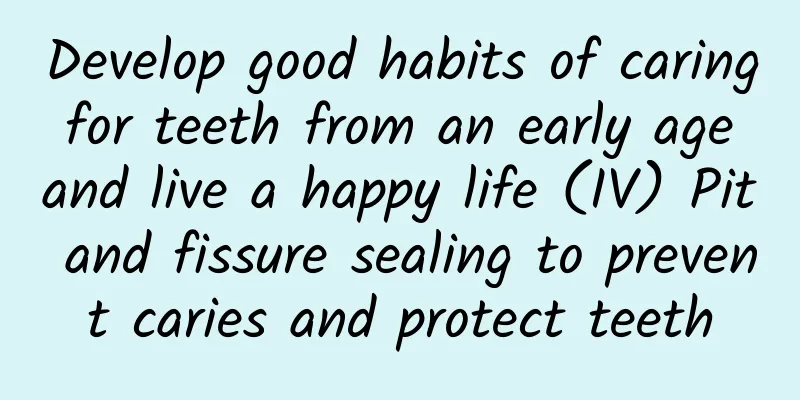Develop good habits of caring for teeth from an early age and live a happy life (IV) Pit and fissure sealing to prevent caries and protect teeth

|
Children's dental caries are more likely to occur in molars. This is because the chewing surface of molars, that is, the surface used for chewing food, is uneven, with many criss-crossing depressions and grooves, which are called pits and fissures. If the teeth are not well developed, these pits and fissures are deep and narrow. Once food and bacteria are embedded in them, it is difficult to clean them out by brushing teeth and rinsing the mouth. These pits and fissures become a breeding base for bacteria, and dental caries are prone to occur. When dental caries occur in pits and fissures, they often progress rapidly, and large dental cavities are hidden under the small black spots (Figure 1, Figure 2). Figure 1 Figure 2 In order to keep bacteria out of the pits and fissures, doctors will apply a layer of resin material to these grooves, which can not only isolate the erosion of bacteria and their metabolites, but also facilitate cleaning, just like putting a layer of protective clothing on the teeth. This is pit and fissure sealing. The best time to seal the pits and fissures is when the teeth are fully erupted and caries have not yet occurred. Note that when the teeth are fully erupted and the erupting teeth are covered by the gums, pit and fissure sealing cannot be performed temporarily. According to the order of eruption of permanent teeth, the best time to seal the first permanent molars is between 6 and 8 years old, the second permanent molars are between 11 and 13 years old, and the permanent premolars are between 9 and 13 years old (Figure 3). Figure 3 Pit and fissure sealing is a painless and non-invasive operation that will not damage teeth. Pit and fissure sealing is divided into six steps (as shown below): ① First, use a small brush to clean the tooth surface. This step does not require grinding and will not cause pain. Just like brushing your teeth in the morning and evening, the doctor will use a small brush to clean the dirt on the surface of the teeth. ② The second step is to put cotton rolls on both sides of the teeth, or put on a small raincoat (rubber dam) for the teeth to isolate saliva, and then use a small brush to apply the etchant to the pits and fissures on the teeth; ③ The third step is to rinse off the etchant on the teeth, and then blow dry the surface of the teeth. At this time, the teeth are white like this, which is normal. ④ The fourth step is to apply pit and fissure sealant on the pits and fissures with a small brush. ⑤ The fifth step is to use a light curing lamp (blue) to irradiate the tooth surface to harden the sealant on the pits and fissures. ⑥ The next and last step is to check whether the sealant is completely cured with a probe, and whether there are bubbles and missed pits and fissures (Figure 4). Figure 4 Some parents may ask, "If my child does not have caries, does he still need to do pit and fissure sealants?" The answer is yes. First of all, pit and fissure sealants are performed on healthy teeth that do not have caries but are prone to caries. However, pit and fissure sealants are not a one-time solution. After pit and fissure sealants are performed, you should not be careless, as there is still a possibility of caries. Pit and fissure sealants are only effective in preventing pit and fissure caries. Even if we have done pit and fissure sealants, if we do not pay attention to oral hygiene and food residues remain on the teeth, the bacteria on the tooth surface will break down the sugar in the food to produce acid, which will damage the teeth and still form caries on the smooth surface of the teeth. Moreover, as we use our teeth, there is a certain probability that the sealant will fall off. If the sealant is worn or falls off, the risk of pit and fissure caries will increase. Therefore, children should go to the dental hospital for regular checkups, and have the appropriate teeth sealed in time to protect the teeth. After the sealant, doctors recommend that regular checkups should be conducted 3 months, 6 months, 1 year, and every year thereafter to check the protective coating of the teeth. author: Lu Youguang, Stomatological Hospital of Fujian Medical University Si Yan, Peking University School of Stomatology Contributed by the Oral Preventive Medicine Committee of the Chinese Stomatological Association The pictures in this article are from "Things that Affect Children's Lives - Children's Oral Health Care" published by People's Medical Publishing House |
<<: What are the famous buildings in Mexico? What fruits are there in Mexico?
>>: When is avocado in season? How to choose avocado
Recommend
Routine gynecological care
To prevent gynecological inflammation, you need t...
Slight bleeding after sex
Men and women must be careful when having sex. It...
Prevention of lobular hyperplasia of the breast
For female friends, getting sick is a common thin...
Can formaldehyde cause miscarriage?
If pregnant women want their babies to be born he...
What to do if you get "hot" after eating oranges, eating melon seeds, and drinking beverages during the Chinese New Year? 4 ways to relieve it
During the holidays at home, I can’t stop eating ...
Things to note during the thirteenth week of pregnancy
It is the thirteenth week of pregnancy, and the p...
What should women do if they have iron deficiency anemia?
According to surveys conducted by relevant depart...
How should a 43-year-old woman maintain her appearance?
In many cases, women need to take care of themsel...
How to do uterine cleaning? Women should keep these methods in mind!
Human life activities will produce a lot of garba...
What is brown discharge after period?
Menstrual problems are an eternal topic for femal...
Symptoms of menopause in women
We know that women enter menopause around the age...
Do you need to peel the dried persimmons when making them? Why do you need to peel the dried persimmons when making them?
We all know that dried persimmons are made from f...
Twitter Chief Revenue Officer: As of November 2011, Twitter has 2,400 advertisers
On December 1, 2011, Twitter Chief Revenue Office...
[Fat Bear Science] Skin rash, diarrhea, elevated transaminase... Ten questions about taking targeted drugs have professional answers. Write them down quickly!
In addition to traditional surgery, radiotherapy ...
Introduction to preventive measures for common breast diseases in women
Nowadays, breast diseases in women have become yo...









